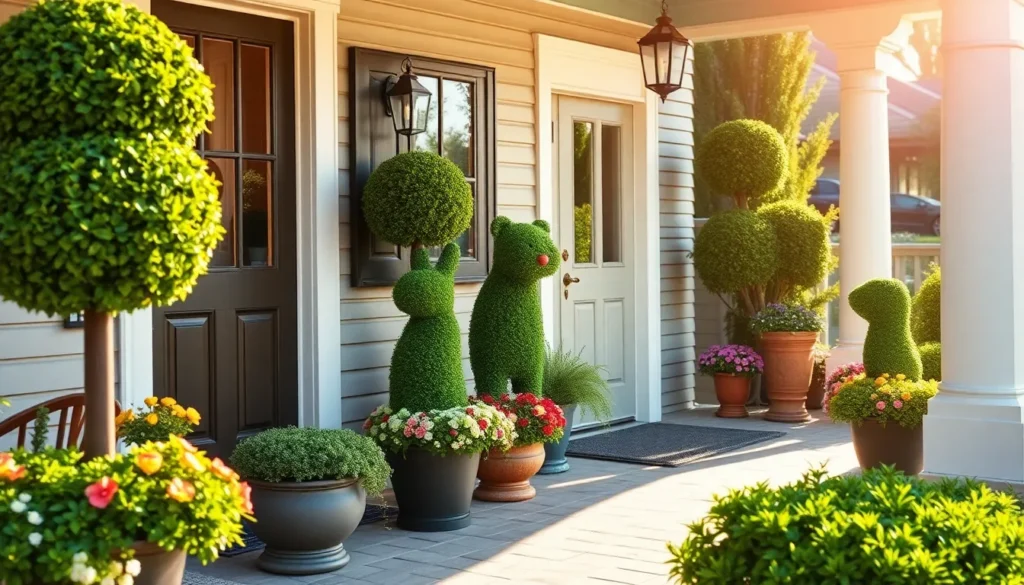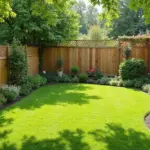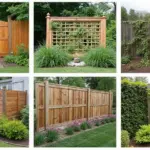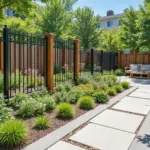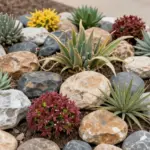Your front porch is the first impression guests get of your home and adding elegant topiaries can instantly transform this space from ordinary to extraordinary. We’ve discovered that these sculpted plants create stunning focal points while adding sophisticated charm that elevates your home’s curb appeal year-round.
Whether you’re working with a sprawling wrap-around porch or a cozy entryway we’ll show you how topiaries can maximize your space’s potential. From classic boxwood spheres flanking your front door to creative spiral designs that add vertical interest these versatile plants offer endless possibilities for every style and budget.
We understand that choosing the perfect topiary arrangement can feel overwhelming with so many shapes sizes and plant varieties available. That’s why we’ve compiled the most inspiring front porch topiary ideas that’ll help you create an inviting entrance that reflects your personal style while boosting your property value.
Classic Boxwood Topiary Shapes for Elegant Front Porches
Boxwood topiaries remain the gold standard for sophisticated front porch decorating because they maintain their structure year round and adapt to various architectural styles. We’ll explore the most timeless shapes that create lasting elegance for your entrance.
Traditional Sphere and Ball Topiaries
Spherical boxwood topiaries offer the perfect balance of formality and approachability for front porch displays. These round shapes work exceptionally well when placed in matching pairs on either side of your entrance door, creating a symmetrical welcome that guests immediately notice. We recommend starting with 24-inch diameter spheres for standard sized porches, as they provide substantial visual impact without overwhelming smaller spaces.
Single large ball topiaries make stunning centerpieces for wide front steps or spacious porch corners. Pairing different sized spheres creates visual interest through layered heights, with 18-inch, 24-inch, and 30-inch combinations being particularly effective. These versatile shapes complement both traditional colonial homes and modern farmhouse designs, making them our most recommended choice for homeowners seeking classic appeal.
Pyramid and Cone-Shaped Designs
Pyramid topiaries bring vertical drama to front porch arrangements while maintaining the refined elegance boxwood provides. These upward pointing shapes naturally draw the eye toward your entrance, making them ideal for porches that need height enhancement. We suggest 36-inch tall pyramids for standard doorway flanking, as they create impressive presence without blocking windows or architectural details.
Cone shaped topiaries offer slightly softer lines than their pyramid counterparts while delivering similar vertical impact. These shapes work beautifully in corner arrangements where you want to soften harsh architectural angles. Multiple cone topiaries in graduated heights create cascading effects that add sophisticated movement to static porch designs.
Spiral Topiary Arrangements
Spiral boxwood topiaries introduce artistic flair to front porch settings through their sculptural twisted forms. These ever-changing shapes serve as conversation starters while maintaining the classic appeal that boxwood naturally provides. We recommend 42-inch tall spirals for dramatic single specimen displays that transform ordinary porches into gallery worthy entrances.
Double and triple spiral arrangements create even more visual complexity when space allows. These intricate shapes require more maintenance than basic geometric forms but reward homeowners with truly unique curb appeal. Positioning spiral topiaries near porch lighting enhances their sculptural qualities during evening hours, creating shadow patterns that add another layer of visual interest to your front entrance design.
Creative Animal-Shaped Topiaries to Welcome Guests
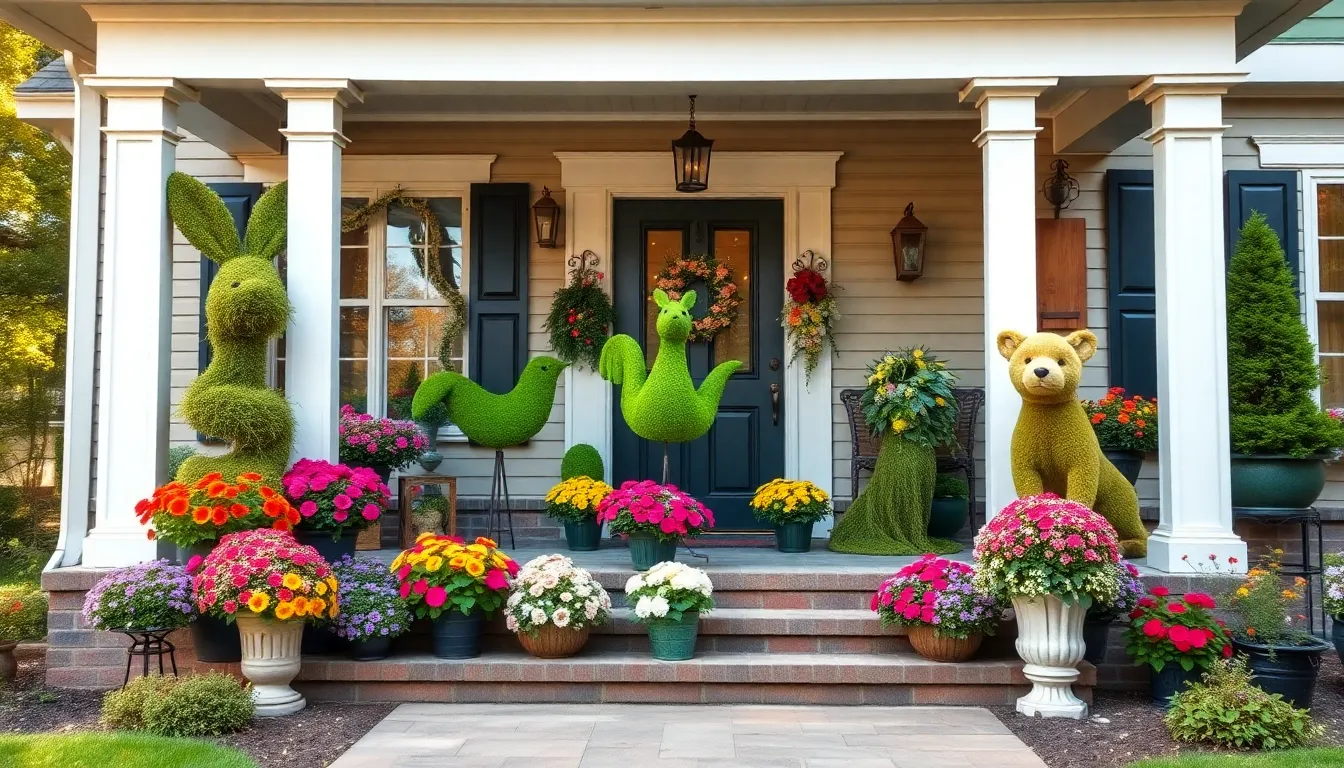
Moving beyond traditional geometric forms, animal-shaped topiaries bring personality and whimsy to your front porch entrance. These sculpted greenery pieces create distinctive focal points that warmly welcome guests while reflecting your unique style.
Bunny and Bird Topiary Designs
Bunny topiaries transform your porch into a charming spring showcase, especially during Easter season when their rabbit silhouettes create festive appeal. Crafting these designs from boxwood or high-quality artificial greenery ensures they maintain their adorable shape throughout the year. We recommend pairing bunny topiaries with seasonal floral accents like tulips or daffodils to enhance the cheerful vibe.
Bird topiaries offer natural elegance whether you choose perched or flight-inspired designs that complement garden themes perfectly. These sculpted forms work beautifully as standalone pieces or grouped arrangements that create visual movement on your porch. Creating bird shapes from live trimmed plants provides authentic appeal, while realistic faux alternatives deliver all-season durability without seasonal maintenance concerns.
Dog and Cat Shaped Garden Art
Pet-shaped topiaries celebrate your love for furry companions while adding personalized charm to your porch décor. These custom designs reflect homeowner personality and create conversation starters that guests always remember. Sculpting these forms from boxwood ensures longevity, while artificial materials provide weather-resistant alternatives that maintain their playful appearance year-round.
Dog and cat topiaries serve as elegant art pieces that balance whimsy with sophistication on any front porch design. We find these shapes work exceptionally well when crafted from materials that require minimal maintenance yet deliver maximum visual impact. Positioning pet-shaped topiaries near your entrance creates an immediate connection with visitors who appreciate the personal touch.
Seasonal Animal Themes
Spring animal themes include bunny, chick, and butterfly shapes that celebrate renewal and growth throughout the season. These designs pair beautifully with fresh plantings and pastel color schemes that enhance your porch’s welcoming atmosphere.
Summer displays feature birds, butterflies, and dragonflies that capture the season’s energy and movement. We love how these lighter themes complement outdoor entertaining spaces and garden-inspired porch arrangements.
Fall arrangements showcase owls, squirrels, and pumpkins with carved animal faces that embrace autumn’s cozy spirit. These seasonal transitions keep your porch décor fresh while maintaining the animal theme throughout changing weather.
Winter designs incorporate reindeer, polar bears, and festive birds that celebrate holiday traditions while withstanding harsh weather conditions. Using UV-resistant faux topiaries ensures your seasonal displays maintain their beauty through extreme temperatures without requiring constant care or replacement.
Geometric Topiary Patterns for Modern Front Porch Aesthetics
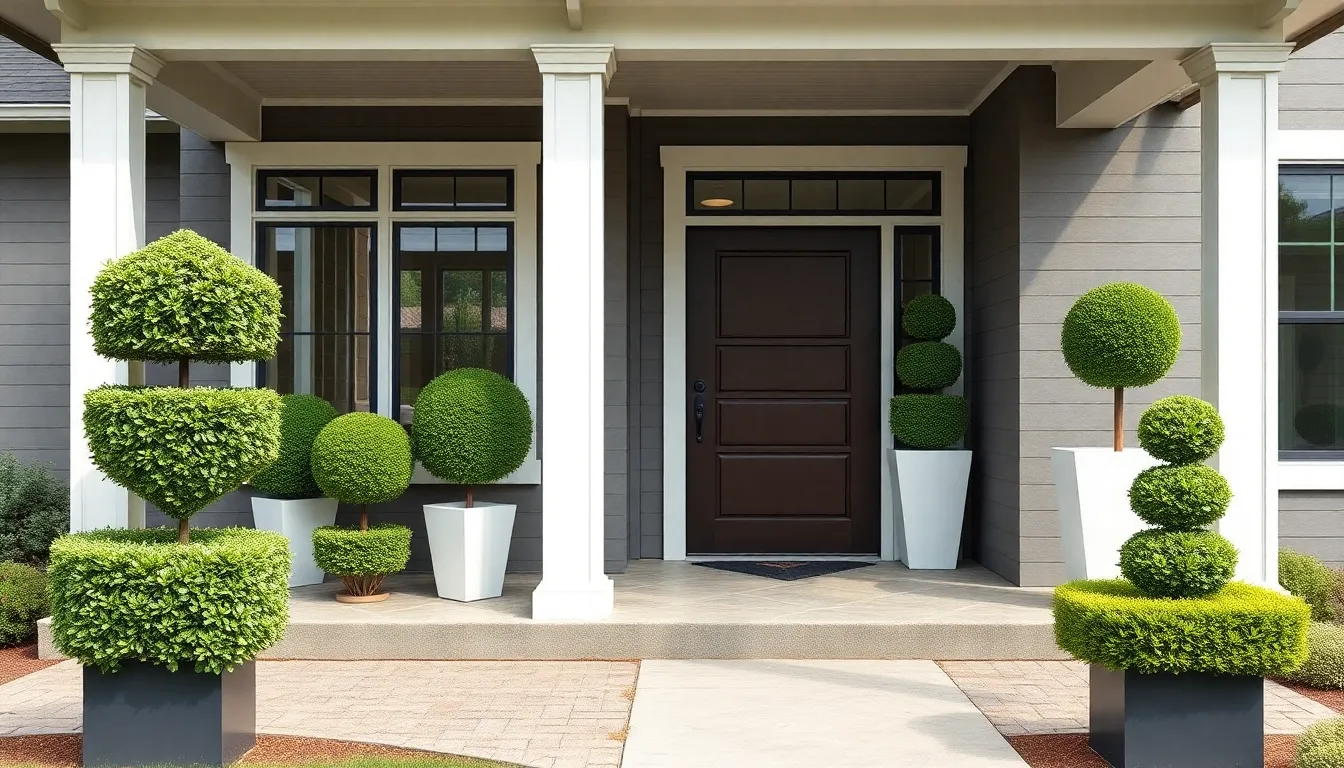
Moving beyond traditional and whimsical designs, geometric topiary patterns offer clean lines and contemporary appeal that perfectly complement modern architectural styles.
Cube and Square Topiary Forms
Cube and square topiaries deliver the ultimate in structured elegance for contemporary front porches. These geometric forms excel at defining space while creating visual balance through their crisp, clean lines. We recommend positioning them symmetrically to flank doorways or steps, where they’ll establish a welcoming yet sophisticated entrance. Boxwood, yew, and buxus varieties hold these sharp edges exceptionally well, maintaining their architectural appeal throughout the seasons.
Placement versatility makes cube topiary forms ideal for both formal and casual garden styles. They work beautifully for dividing planting areas or creating defined borders along pathways. We’ve found these shapes particularly effective on modern porches where they echo the home’s angular architecture while softening harsh building materials.
Diamond and Hexagonal Shapes
Diamond shaped topiaries introduce visual intrigue while maintaining the clean aesthetic modern homeowners desire. These angular forms work exceptionally well as singular statement pieces or paired arrangements that add texture and depth to porch displays. We recommend hexagonal shapes for homeowners seeking complexity without overwhelming smaller porch spaces.
Sculptural contrast becomes the key benefit when incorporating diamond and hexagonal topiaries against traditional home facades. While these forms require more precise clipping techniques than basic cubes, they deliver a highly stylized aesthetic that sets your entrance apart. We suggest starting with one complex shape before adding multiple geometric elements to avoid visual clutter.
Tiered Geometric Arrangements
Tiered geometric designs stack multiple shapes vertically to create ever-changing displays perfect for narrow porch areas. We love combining cubes, spheres, and pyramids in vertical arrangements that maximize visual impact when horizontal space is limited. These sophisticated compositions work particularly well in terracotta containers or rustic planters that complement Mediterranean or French country architectural styles.
Height advantages make tiered topiaries excellent answers for small porches requiring vertical drama. We recommend artificial alternatives for challenging growing conditions, as they provide year-round lushness without maintenance concerns. These stacked arrangements deliver layered elegance while maintaining the sharp, modern aesthetic that geometric patterns provide.
Seasonal Front Porch Topiary Ideas Throughout the Year
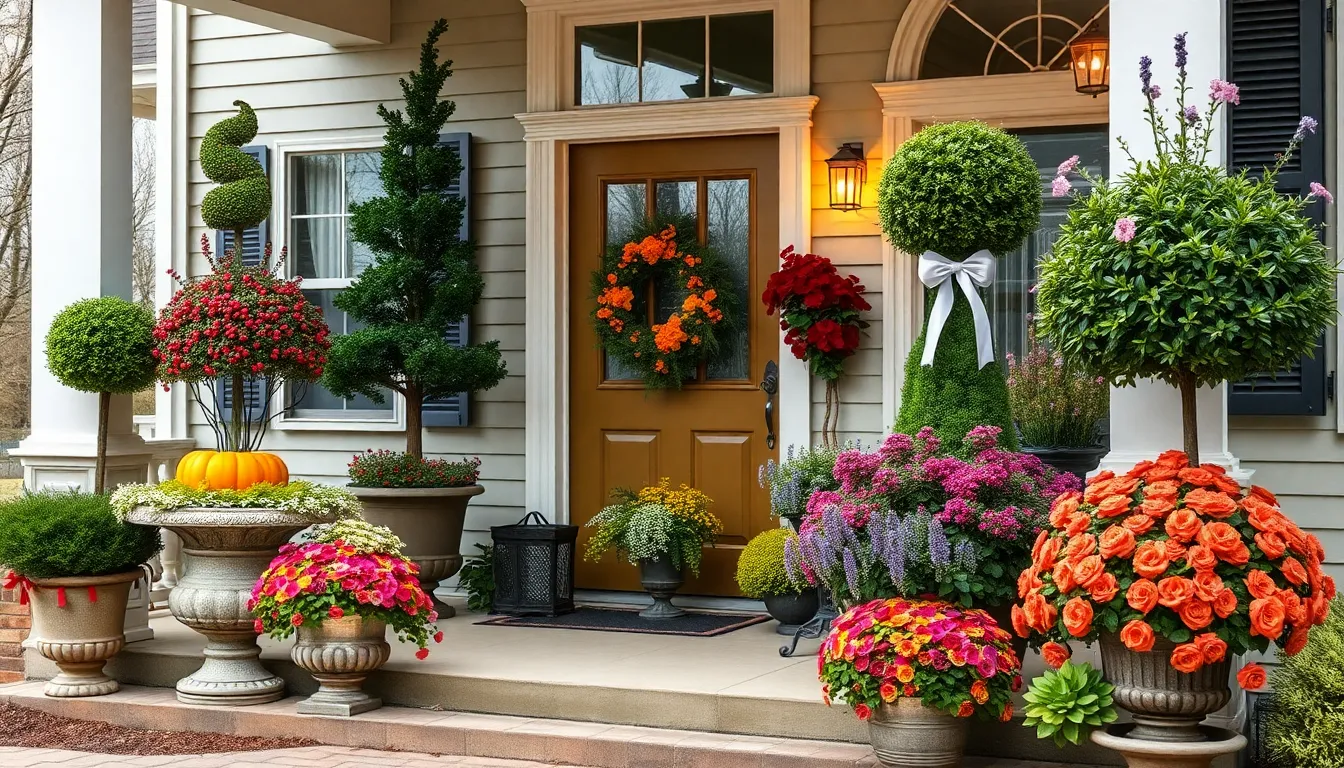
Adapting your front porch topiary displays to match the changing seasons keeps your entrance fresh and welcoming. Seasonal transitions allow us to showcase different plants, colors, and decorative elements that complement nature’s rhythm.
Spring Flowering Topiary Combinations
Spring awakens our front porches with vibrant blooms and fresh growth that breathe life into winter’s dormant industry. Flowering plants like azaleas, hydrangeas, and lavender create stunning combinations when paired with classic evergreen topiary shapes such as boxwood spheres or cones. We recommend incorporating pastel-colored blooms around the base of your topiary arrangements to establish a cheerful spring display that welcomes guests with seasonal charm.
Flowering vines twisted around spiral topiaries add remarkable color and texture that transforms simple geometric forms into living art pieces. These combinations work exceptionally well because they blend structured formality with organic beauty. Consider positioning these arrangements in matching planters to create symmetrical balance while allowing each plant’s natural characteristics to shine through the carefully maintained topiary framework.
Summer Herb and Foliage Displays
Summer presents the perfect opportunity to showcase fragrant herb topiaries that offer both visual appeal and practical benefits for your kitchen. Rosemary and thyme topiaries provide delightful scents that greet visitors while maintaining their structured shapes throughout the warmer months. We suggest combining these aromatic herbs with summer-friendly foliage plants like ornamental grasses or colorful coleus varieties to create ever-changing displays with varying textures and heights.
Keeping your summer topiary plants in attractive containers offers flexibility for repositioning and ensures easier watering during hot weather. This approach allows us to move arrangements to optimize sunlight exposure or create shade for more delicate plants. Container gardening also simplifies the transition to fall arrangements when it’s time to bring tender plants indoors or replace them with cold-hardy alternatives.
Fall and Winter Evergreen Arrangements
Evergreen plants form the backbone of successful fall and winter topiary displays because of their remarkable durability and year-round color retention. Boxwood, yew, holly, and privet excel as topiary materials during colder months, maintaining their rich green appearance when other plants enter dormancy. We recommend adding seasonal accents like pumpkins, pinecones, or berry branches around the bases of your evergreen topiaries to celebrate autumn’s harvest theme.
Winter transforms our topiary arrangements into festive focal points through strategic decorating with LED lights, elegant ribbons, or artificial snow effects. These additions create magical displays that capture the holiday spirit while highlighting the topiary’s sculptured form. Faux topiaries present an excellent maintenance-free alternative for harsh climates, offering UV-resistant leaves that stay vibrant throughout winter’s challenging conditions without requiring watering, pruning, or protection from freezing temperatures.
Container and Planter Options for Front Porch Topiaries
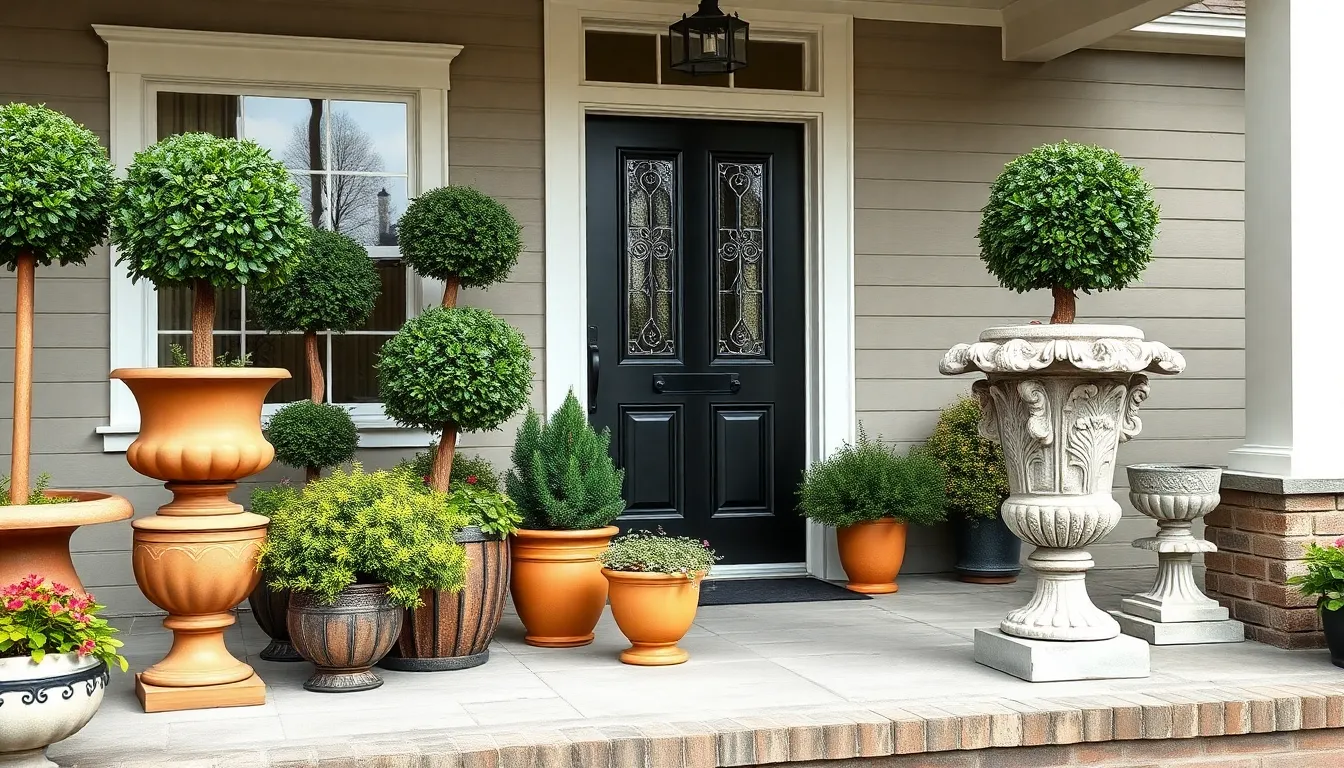
Selecting the perfect container transforms your topiary from a simple plant into a stunning design statement. The right planter enhances your topiary’s sculptural beauty while complementing your porch’s architectural style.
Traditional Terracotta and Ceramic Planters
Terracotta planters bring warmth and timeless elegance to front porch topiary displays. Their earthy tones create natural harmony with evergreen foliage while providing excellent breathability for healthy root development. Classic ceramic containers offer expanded design possibilities with glazed finishes in various colors and patterns that add decorative flair without sacrificing outdoor durability.
We recommend pairing terracotta pots with boxwood spheres for a Mediterranean inspired look that works beautifully with traditional home styles. Ceramic planters with subtle glazes complement geometric topiaries perfectly while maintaining the sophisticated appearance you’re seeking. These natural materials age gracefully outdoors, developing attractive patina that enhances their character over time.
Modern Metal and Concrete Containers
Metal and concrete planters deliver sleek contemporary appeal for modern front porch designs. Steel and aluminum containers offer lightweight durability with powder coated finishes that resist weather damage while maintaining their crisp appearance. Geometric shapes in these materials enhance the sculptural qualities of your topiaries, creating striking visual contrast.
Concrete planters provide exceptional stability for taller topiary designs while offering an industrial aesthetic that complements modern architecture. We find these containers particularly effective for spiral topiaries and pyramid shapes that benefit from the substantial base. The minimalist lines of metal and concrete planters allow your topiary’s form to take center stage without competing visual elements.
Decorative Urns and Statement Pieces
Decorative urns elevate topiaries into formal focal points that command attention at your front entrance. Stone, resin, and cast concrete urns feature intricate detailing that adds classical elegance to traditional home exteriors. These larger containers accommodate substantial root systems while creating impressive displays that enhance curb appeal significantly.
Statement planters in bold colors or unusual designs reflect your personal style while making topiaries conversation starters. We suggest selecting urns with proportions that complement your topiary’s mature size to maintain visual balance. Ornamental containers work exceptionally well with animal shaped topiaries, where the decorative base enhances the whimsical nature of the display while providing artistic cohesion.
Best Plants for Creating Stunning Front Porch Topiaries
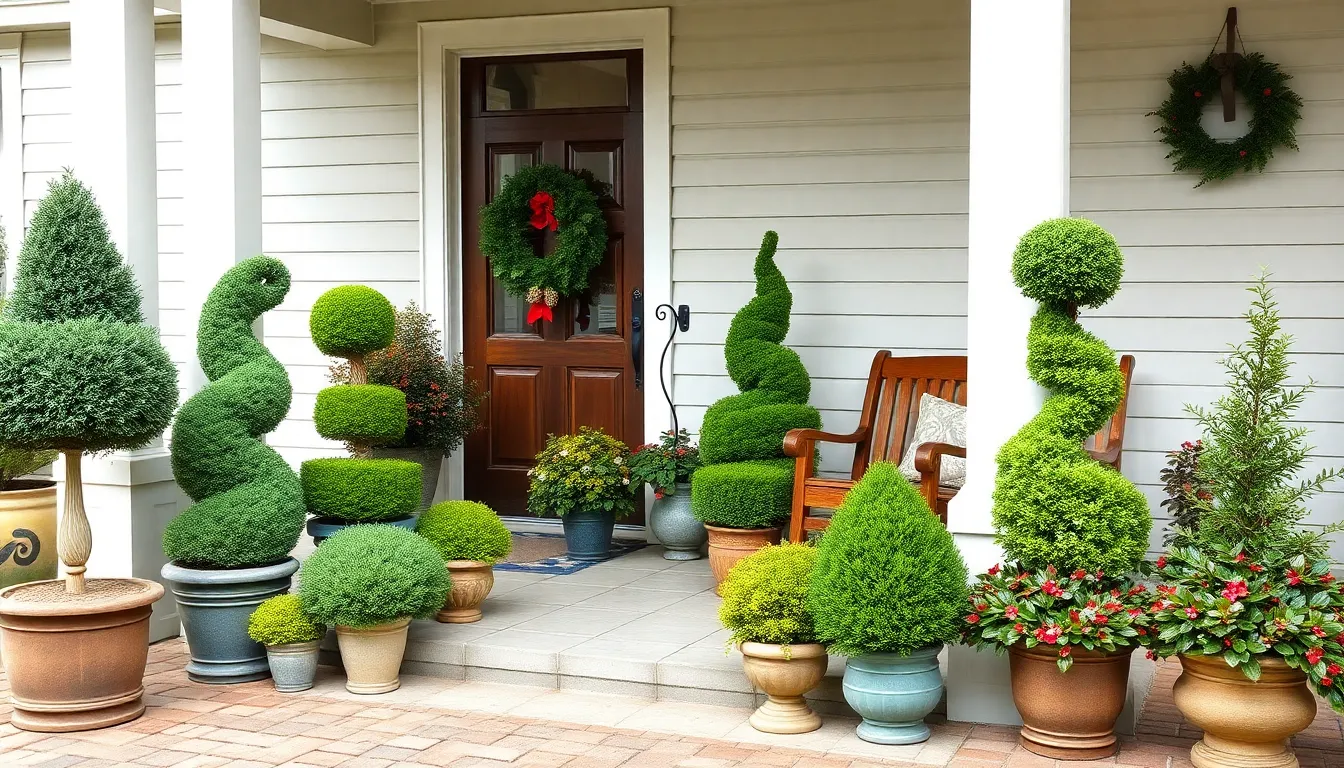
Selecting the right plants forms the foundation of any successful topiary project. We’ve researched the most effective options to help you create beautiful, lasting displays.
Evergreen Shrubs for Year-Round Appeal
Boxwood remains the gold standard for front porch topiaries, offering dense evergreen foliage that maintains its sophisticated appearance through all seasons. We recommend this classic choice because it shapes easily into spheres, spirals, and even animal forms while providing that timeless elegance homeowners love.
Holly varieties, particularly Emerald Colonnade®, deliver broadleaf evergreen beauty with small foliage that resembles boxwood but grows taller. This variety thrives in full sun and warmer zones, making it perfect for cone-shaped topiaries like pyramids and spirals.
Yew plants provide excellent year-round structure and complement boxwood beautifully in mixed arrangements. These tough, easy-care evergreens maintain their rich green color throughout winter months when other plants fade.
Juniper varieties offer natural spiral and pom pom shapes that require minimal training. Mint Julep junipers work well for various topiary forms, while Spartan varieties excel in tall, slender designs that add vertical interest to your porch.
Fast-Growing Options for Quick Results
Juniper shrubs grow relatively fast compared to traditional boxwood, allowing you to achieve impressive topiary shapes in less time. We’ve found that these hardy, sun-tolerant evergreens deliver quick curb appeal while maintaining their sculptural form.
Brush Cherry provides rapid growth in warmer climates, featuring colorful new foliage and occasional small white flowers. This fast-growing option works exceptionally well for cones, pom-poms, and spiral designs that need to fill out quickly.
Eugenia offers faster establishment than many traditional topiary plants while maintaining the refined appearance you want. Known for its dainty leaves and adaptable nature, this plant suits homeowners who want beautiful results without extended waiting periods.
Low-Maintenance Topiary Plant Varieties
Eugenia stands out for requiring minimal pruning and general upkeep while maintaining its aesthetic appeal throughout the growing season. We appreciate this variety’s versatility in shaping combined with its forgiving nature for busy homeowners.
Boxwood varieties need only occasional trimming to maintain their shape, making them ideal for those who want stunning topiaries without constant maintenance. These resilient plants tolerate various growing conditions while keeping their dense, professional appearance.
Faux topiaries provide a zero-maintenance solution with everlasting curb appeal for homeowners who want the look without any plant care. While artificial, high-quality options offer UV resistance and maintain their appearance through harsh weather conditions.
Topiary Placement and Arrangement Ideas for Maximum Impact
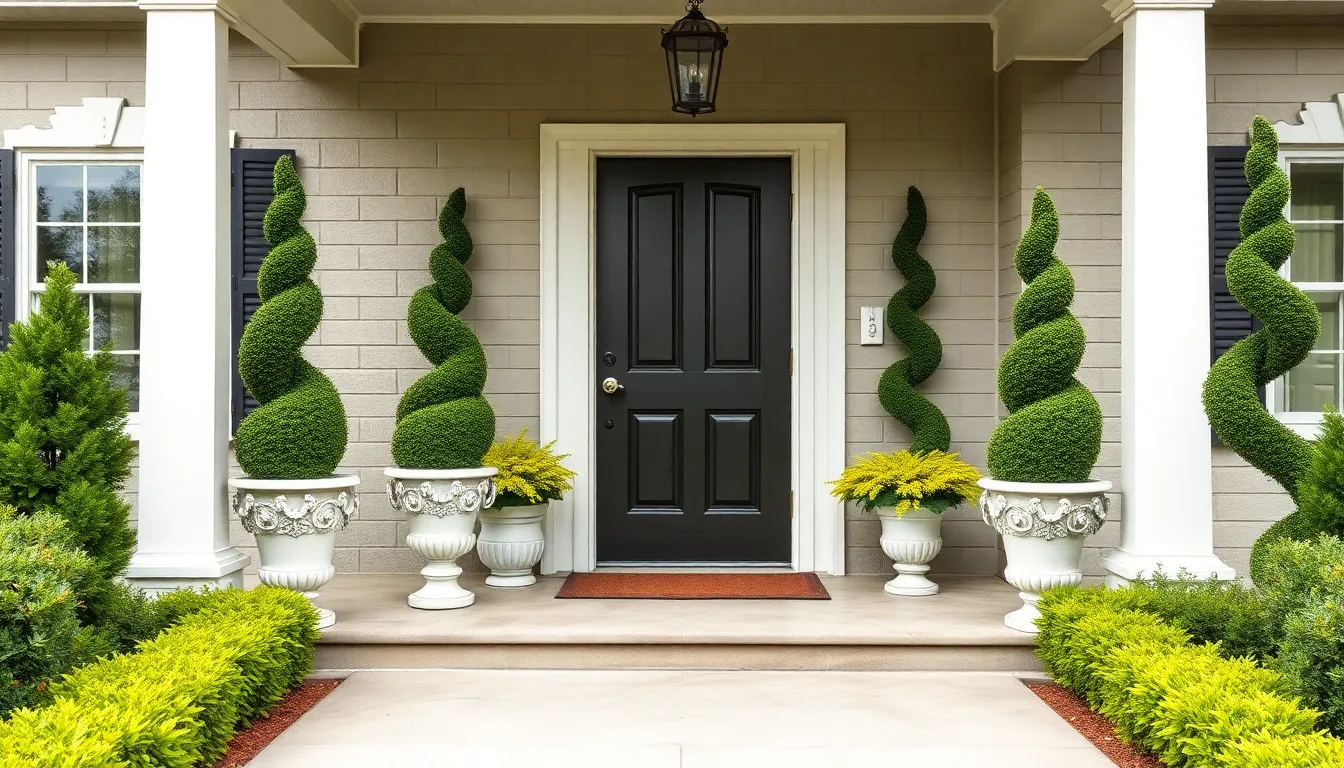
Now that we’ve explored different topiary styles and containers, let’s focus on strategic placement techniques that’ll maximize their visual impact on your front porch.
Symmetrical Pairings and Formal Layouts
Symmetrical arrangements create the most dramatic and welcoming entrance effect. Positioning identical topiary plants on either side of your front door establishes a formal, balanced look that naturally draws visitors’ eyes to your entryway. We recommend using matching cone or spiral shaped topiaries in identical containers for maximum impact.
Traditional architectural styles benefit most from this classic approach. The symmetrical placement emphasizes order and elegance while creating a stately appearance that complements colonial, Victorian, and Georgian home designs. Using matching pots enhances the overall symmetry and adds sophistication to your porch display.
Boxwood spheres work exceptionally well for formal symmetrical designs. These classic shapes provide year round structure and maintain their polished appearance through all seasons. We suggest selecting topiaries of identical size and shape to achieve the perfect balance that makes your entrance feel both welcoming and refined.
Asymmetrical and Casual Groupings
Asymmetrical groupings offer a more relaxed and inviting alternative to formal arrangements. This approach involves varying the size, shape, and container styles of your topiary plants while placing them in non identical arrangements around your porch space. Modern and eclectic home exteriors particularly benefit from this creative freedom.
Combining different topiary shapes creates visual interest without rigid formality. We recommend mixing spheres with pyramids or spirals in staggered groupings to add personality to your porch display. This technique works especially well when you incorporate other planters or seasonal floral accents alongside your topiaries.
Casual arrangements allow for creative expression in your greenery displays. You can experiment with different heights and textures while maintaining an cohesive look through coordinated color schemes or complementary container materials. This flexibility makes asymmetrical groupings perfect for homeowners who prefer a more organic, lived in aesthetic.
Layered Height Arrangements
Layered height arrangements add dimension and depth to your porch décor. This technique involves placing taller topiary plants near focal points like doorways while positioning shorter or medium height specimens on steps, corners, or side areas. The resulting vertical flow guides visitors’ attention naturally along your porch space.
Mixing topiary shapes at different heights creates sophisticated visual texture. We suggest combining spheres, spirals, and cones in varying heights to establish a ever-changing display that feels both structured and organic. This approach works particularly well on larger porches where you have room to create multiple visual layers.
Strategic height placement maximizes your porch’s architectural features. Taller topiaries can frame doorways or highlight columns while shorter ones define seating areas or walkway edges. Adding complementary flowers or decorative elements at the base of your topiaries enhances the overall presentation and creates conversation starting focal points throughout your entrance area.
Maintenance Tips for Healthy Front Porch Topiaries
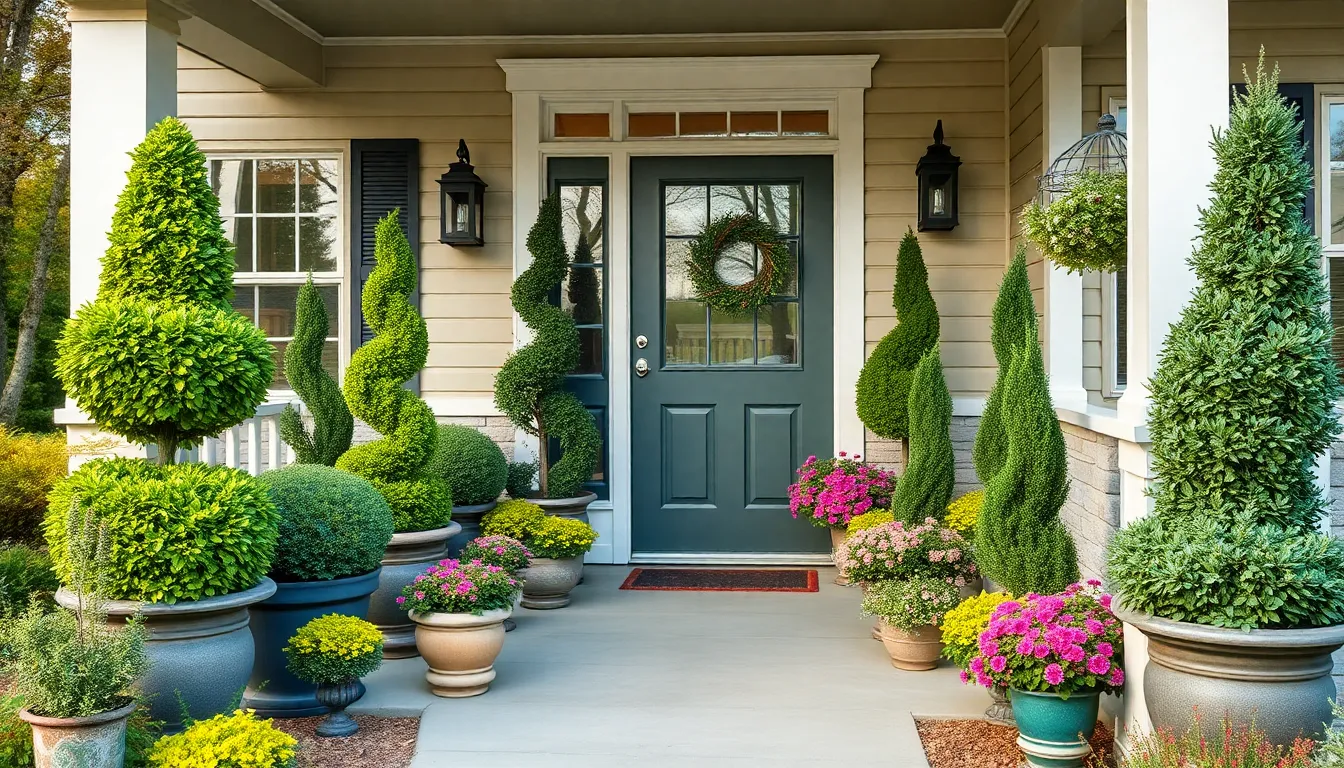
Creating stunning topiary displays on your front porch requires ongoing care to maintain their elegant appearance. We’ll share essential maintenance techniques that keep your sculptured plants thriving throughout the seasons.
Proper Pruning and Shaping Techniques
Regular trimming sessions preserve your topiary’s desired shape while promoting healthy growth. We recommend pruning consistently during the growing season rather than making dramatic cuts all at once.
Small incremental cuts work better than removing large portions of foliage. Never remove more than 25% of the foliage at once to prevent plant stress and maintain your topiary’s structural integrity.
Wire molds and frames help guide vine types like English ivy and creeping fig into desired shapes. These support structures are particularly useful for beginners learning to train their plants into exact forms.
Evergreen shrub varieties like boxwood, cypress, and myrtle tolerate frequent pruning better than other plant types. Choosing these hardy species ensures your front porch topiaries maintain their shape with regular maintenance sessions.
Watering and Fertilizing Schedules
Consistent moisture levels keep topiary plants healthy without creating soggy soil conditions. Container topiaries on front porches typically need more frequent watering than ground planted specimens due to faster drainage.
Balanced slow release fertilizers support healthy growth and dense foliage during the growing season. We apply these nutrients according to package directions to maintain optimal plant health without encouraging excessive growth.
Overfertilizing concerns include distorted shapes and uncontrolled growth that ruins carefully maintained topiary forms. Moderate feeding schedules produce better results than heavy fertilization programs.
Seasonal Care and Protection
Extreme weather protection involves moving container topiaries to sheltered areas during harsh winters or intense summer heatwaves. Indoor storage or covered porch areas provide necessary protection for delicate specimens.
Dormant season watering requires reduced frequency while preventing complete soil dryness. We monitor soil moisture levels carefully during winter months to maintain plant health without overwatering.
Pest and disease monitoring becomes crucial for maintaining healthy topiary plants throughout changing seasons. Regular inspections help identify problems early before they damage your carefully shaped front porch displays.
Container repotting schedules every few years refresh soil nutrients and manage root growth in potted topiaries. Fresh potting mix and root pruning keep container plants healthy and vigorous for continued shaping success.
Budget-Friendly DIY Front Porch Topiary Projects
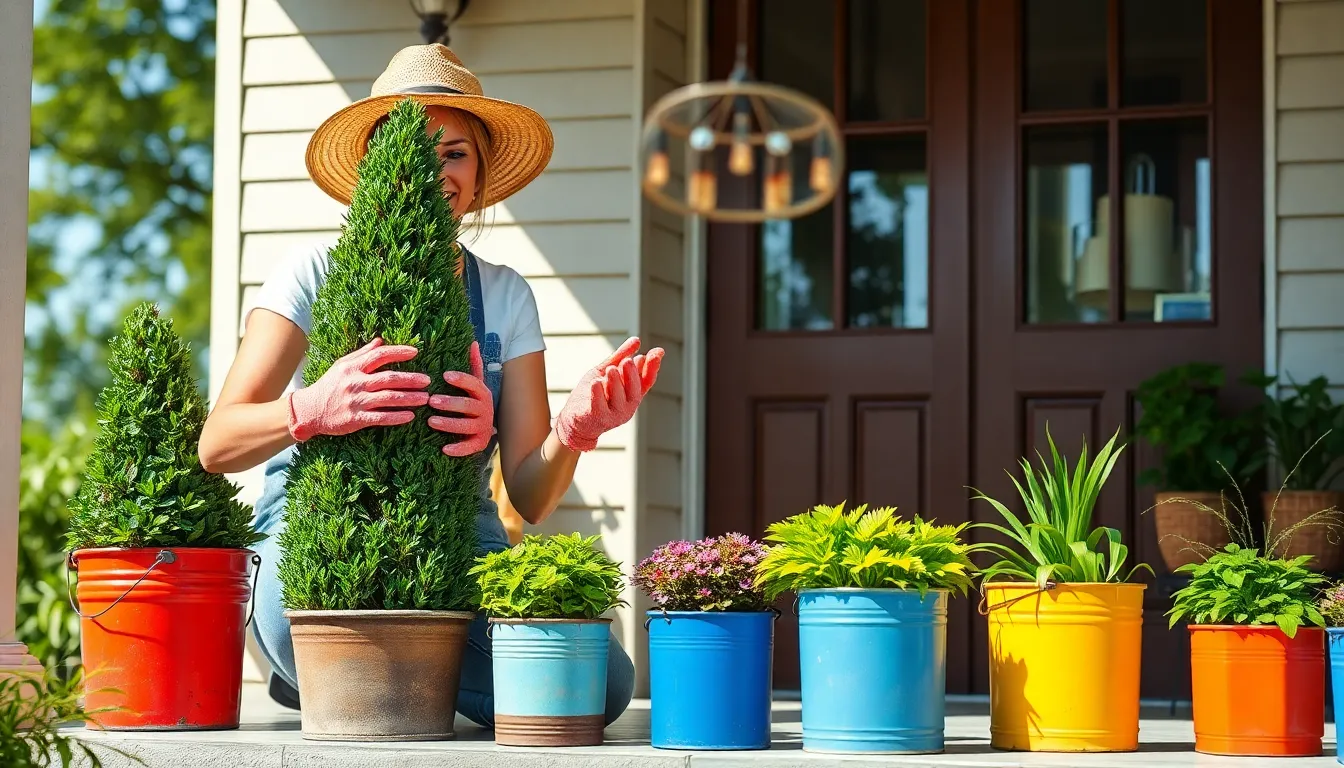
Creating stunning topiary displays doesn’t require a substantial investment or professional landscaping skills. We’ll explore cost-effective approaches that deliver impressive results while keeping your budget intact.
Creating Topiaries from Young Plants
Starting with young, affordable evergreen plants offers the most budget-friendly path to beautiful topiary displays. Boxwood, holly, and myrtle saplings cost significantly less than mature specimens and adapt more easily to shaping techniques. Young plants respond better to training with topiary frames, allowing us to guide their growth into classic forms like spheres, cones, and spirals over time.
Regular pruning sessions help maintain clean lines and desired shapes without requiring costly plant replacements. We recommend beginning with simple geometric forms before attempting more complex designs. This gradual approach builds confidence while keeping initial costs low. Training young plants requires patience, but the results rival expensive pre-shaped topiaries from nurseries.
Repurposing Household Items as Planters
Transforming everyday household items into unique planters adds character while reducing expenses. Old buckets, wooden crates, watering cans, and vintage tins make excellent containers for topiary displays. We’ve found that a fresh coat of paint or decorative touches can turn ordinary objects into charming focal points.
This sustainable approach allows us to reuse items that might otherwise be discarded. Painting containers in coordinating colors creates cohesive displays that complement your home’s exterior. Repurposed planters also offer practical advantages, as they’re typically lighter than traditional containers and easier to relocate seasonally.
Wire Frame and Moss Topiary Alternatives
Wire frames filled with moss or artificial greenery create impressive topiary shapes without living plants. These alternatives require minimal maintenance and provide year-round visual appeal regardless of weather conditions. We can create attractive forms like balls, cones, and abstract shapes using inexpensive wire frames from create stores.
Moss-filled topiaries offer a natural texture that complements outdoor spaces beautifully. Artificial greenery provides consistent color and eliminates watering concerns entirely. These no-maintenance options work particularly well for renters or those seeking low-commitment decorative answers. The initial investment pays off through durability and consistent appearance across all seasons.
Conclusion
We’ve explored countless ways to transform your front porch with stunning topiary displays that reflect your personal style and enhance your home’s curb appeal. From classic boxwood spheres to whimsical animal shapes these living sculptures offer endless possibilities for creating memorable first impressions.
The beauty of front porch topiaries lies in their versatility and year-round appeal. Whether you choose traditional geometric forms modern angular designs or playful seasonal arrangements you’ll create an inviting entrance that welcomes guests and neighbors alike.
With proper plant selection strategic placement and regular maintenance your topiary investment will continue paying dividends for years to come. Even budget-conscious homeowners can achieve professional-looking results through creative DIY approaches and smart container choices.
Your front porch deserves to make a statement and topiaries provide the perfect solution for elevating your home’s exterior from ordinary to extraordinary.
Frequently Asked Questions
What are the best plants for creating front porch topiaries?
Evergreen shrubs are ideal for front porch topiaries, with boxwood being the gold standard due to its dense foliage and versatility. Other excellent options include holly varieties, yew, and juniper, which provide year-round structure and appeal. For quick results, consider fast-growing options like brush cherry and Eugenia. Faux topiaries offer a zero-maintenance alternative for lasting curb appeal.
How do I choose the right container for my topiary?
Select containers that complement your topiary’s style and your home’s architecture. Traditional terracotta pots work well for Mediterranean looks, while ceramic containers suit geometric topiaries. Modern metal and concrete planters provide sleek appeal for contemporary designs. Decorative urns create formal focal points and work particularly well with whimsical animal-shaped topiaries.
What topiary shapes work best for small front porches?
Geometric shapes like cubes, spheres, and diamond patterns are perfect for smaller spaces as they provide structure without overwhelming the area. Tiered arrangements combining various shapes can maximize visual impact on narrow porches. Consider single statement pieces rather than multiple large topiaries to maintain proportion and avoid cluttering your entrance.
How often should I trim and maintain my topiaries?
Regular trimming during the growing season is essential to maintain shape and promote healthy growth. Prune every 4-6 weeks during spring and summer, reducing frequency in fall and winter. Use wire molds for vine types to guide growth. Consistent watering and balanced fertilization schedules are crucial, along with seasonal protection from extreme weather conditions.
Can I create topiaries on a budget?
Yes! Start with young, affordable evergreen plants that are easier to shape than mature specimens. Repurpose household items like old buckets or vintage tins as unique planters to save money while adding character. Wire frame and moss topiary alternatives require minimal maintenance and provide year-round appeal, making them perfect budget-friendly options.
What seasonal decorating ideas work with topiaries?
Spring pairs evergreen topiaries with vibrant flowering plants like azaleas and lavender. Summer features fragrant herb topiaries such as rosemary and thyme. Fall and winter displays use evergreen foundations enhanced with seasonal accents like pumpkins, pine cones, and LED lights. Faux topiaries maintain vibrant winter displays without maintenance requirements.
How do I arrange multiple topiaries for maximum impact?
Create symmetrical pairings with identical topiaries on either side of your front door for formal, traditional looks. For modern homes, try asymmetrical groupings with varying sizes and shapes. Use layered height arrangements to add dimension and guide visitors’ attention. Combine different topiary shapes and heights to create sophisticated visual texture.
Are animal-shaped topiaries suitable for front porches?
Animal-shaped topiaries add personality and whimsy to front porches, serving as memorable conversation starters. Popular options include bunny topiaries for spring, bird shapes for natural elegance, and pet-shaped designs celebrating furry companions. Choose UV-resistant faux options for harsh weather conditions and consider seasonal animal themes throughout the year.

